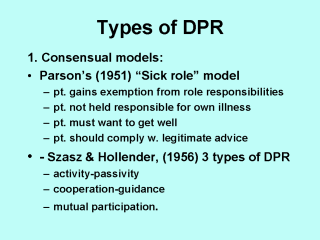| front |1 |2 |3 |4 |5 |6 |7 |8 |9 |10 |11 |review |
 |
There
have been three different ways of looking at the DPR: those that view the DPR as
essentially a consensual event, those that view the DPR as a conflicting event, and those
that view the DPR as a negotiated process. Of course, all three of these models reflect
the evolution of the DPR in the second half of the 20th Century, since the first
consensual models were proposed by Parsons and Szasz & Hollender in the 1950s. The most famous of the consensual models is Parsons’ sick role model. This proposes that in return for the patient being granted the status of being sick, with the exemptions from normal responsibilities and duties this brings, the patient is obliged to follow the doctor’s treatment to get well, so as to return to normal duties as soon as possible. A few years later, Szasz & Hollender classified DPRs into three types: where the doctor is active but the patient passive, where the patient cooperates with the doctor’s guidance and where both doctor and patient mutually participate to achieve the agreed outcome. Parsons’ model has been criticised as applying only to acute episodes and being rather authoritarian. |